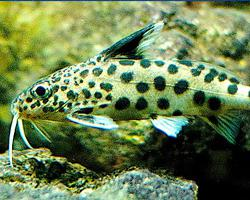
Veszélyeztetettség
| Veszélyeztetett |
Állatleírás
The Cuckoo Catfish, scientifically known as Synodontis multipunctatus, is a captivating species of fish native to the freshwater ecosystems of Lake Tanganyika in East Africa. This intriguing species belongs to the family Mochokidae, commonly referred to as the squeakers or upside-down catfish, due to the unique sounds some species can produce and the unusual swimming behavior observed in several family members. However, what sets the Cuckoo Catfish apart from its relatives is not just its habitat or behavior, but its remarkable breeding strategy, which involves a fascinating form of brood parasitism.Adult Cuckoo Catfish typically exhibit a striking appearance, with their bodies displaying a base color of creamy white to silver, adorned with numerous dark spots and blotches that provide an effective camouflage among the rocky substrates of their natural habitat. These spots are not uniformly distributed, giving each fish a unique pattern. They possess a sleek, streamlined body shape, which is well adapted to their benthic lifestyle, allowing them to navigate through the complex rocky landscapes of Lake Tanganyika with ease. Their barbels, which are whisker-like sensory organs, help them to locate food in the murky waters.
One of the most fascinating aspects of the Cuckoo Catfish is its reproductive strategy, which involves a form of kleptoparasitism. Unlike most fish species, where parental care is a significant part of the reproductive process, Cuckoo Catfish exploit the parental care of mouthbrooding cichlids. During the spawning of certain cichlid species, the female catfish will sneak into the breeding site and lay her eggs among those of the cichlids. In a synchronized manner, the male catfish will then fertilize these eggs. The cichlid, mistaking the catfish eggs for her own, will scoop them into her mouth for safekeeping. The catfish eggs hatch first, and the young will often consume the cichlid eggs or larvae, growing rapidly in a predator-free environment until they are large enough to leave the safety of their unwitting adoptive parent's mouth.
In the aquarium trade, the Cuckoo Catfish is highly valued not only for its unique reproductive behavior but also for its striking appearance and relatively peaceful nature, making it a fascinating addition to community tanks that replicate the hard, alkaline water conditions of its natural habitat. However, their predatory nature towards small fish and specific breeding requirements can pose a challenge to aquarists.
Conservation-wise, Synodontis multipunctatus is currently not listed as endangered, but like many species native to Lake Tanganyika, it faces threats from habitat destruction, pollution, and the potential impacts of climate change. Sustainable practices in both the aquarium trade and local fisheries are crucial for ensuring the long-term survival of this remarkable species in the wild.
In summary, the Cuckoo Catfish is a remarkable example of the diversity and complexity of aquatic life, showcasing unique adaptations that allow it to thrive in one of the world's oldest and most biodiverse lakes. Its intriguing life cycle and behavior continue to fascinate scientists and aquarium enthusiasts alike, making it a subject of ongoing study and admiration.
Új állatfotók
Top 10 állat
- Diana monkey (Cercopithecus diana)
- Dolphin gull (Leucophaeus scoresbii)
- Moustached guenon (Cercopithecus cephus)
- Galápagos tortoise (Geochelone nigra complex)
- Stone loach (Barbatula barbatula)
- Japanese spider crab (Macrocheira kaempferi)
- Colossal squid (Mesonychoteuthis hamiltoni)
- Common house mosquito (Culex pipiens)
- Common reed warbler (Acrocephalus scirpaceus)
- Sea urchins (Echinoidea)